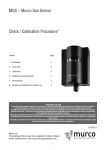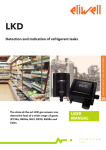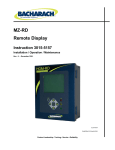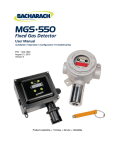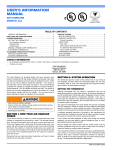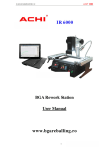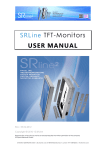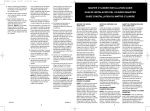Download murco MGS Operating instructions
Transcript
MGS – Murco Gas Sensor EC / SC model Gas Detector and Transmitter Installation & Operation* Content Page 1- Installation Instructions 2 2- Location Instructions 2 3- Typical Settings 2 4- Installation and Wiring Diagrams 2 5- Operating Instructions 2 6- Test/Function Instructions 3 7- Remote sensor head installation 3 8- MGS - Annual test 3 9- 4 Agree Selectable functions with end-users 10- Troubleshooting 4 11- Connections to Murco Control Panels 4 12- Mounting Diagrams 4 *Technician use only This unit must be installed by a suitably qualified technican who will install this unit in accordance with these instructions and the standards set down in their particular industry/country. Suitably qualified operators of the unit should be aware of the regulations and standards set down by their industry/country for the operation of this unit. These notes are only intended as a guide and the manufacturer bears no responsibility for the installation or operation of this unit. Failure to install and operate the unit in accordance with these instructions and with industry guidelines may cause serious injury including death and the manufacturer will not be held responsible in this regard. 08 ASH (1) Murco Ltd. 114a Georges Street Lower, Dun Laoghaire Co Dublin. Ireland, e-mail: [email protected] web: www.murco.ie 1 1- MGS Installation Instructions • With heavier than air gases such as halocarbon and hydrocarbon refrigerants such as R404A, propane, and butane sensors should be located near ground level • With lighter than air gas e.g. ammonia, the sensor needs to be located above the equipment to be monitored on a bracket or high on a wall within 300 mm of, or on the ceiling provided there is no possibility of a thermal layer trapped under the ceiling preventing gas reaching the sensor. (NB. At very low temperatures, such as in a refrigerated cold store, ammonia gas becomes heavier than air). • With similar density or miscible gases, such as CO or CO2, sensors should be mounted about head high – say 1.5m. • Sensors should be positioned a little way back from any high-pressure parts to allow gas clouds to form. Otherwise any leakage of gas is likely to pass by in a high-speed jet and not be detected by the sensor. • Make sure that pits, stairwells and trenches are monitored since they may fill with stagnant pockets of gas. • If a pressure relief vent pipe is fitted to the system, it may be a requirement to mount a sensor to monitor this vent pipe. It should be positioned about 2 m above the PRV to allow gas clouds to form. • With racks or chillers pre-fitted with refrigerant sensors, these should be mounted so as to monitor the compressors or if extract ducts are fitted the airflow in the duct may be monitored. To open the Standard Sensor enclosure: turn the cable gland ½ turn anticlockwise to loosen the internal gland nut, depress the clip on top of the enclosure and open. Reverse to close. Power: 12-24V AC / DC, connect at positions 0V and +V at connector block CN1. For AC – Jumper A is on, D is off. (See Diagram 1/2) For DC – Jumper A is off, D is on. (Default Factory Setting is DC) Use 2 cores of a 4-core cable, low voltage alarm type, typically 7/0.2 mm sq Output: you can select the V or mA analogue output at JP1 and JP3. (Default factory setting is mA) Connect the other two cores of the cable to terminal block CN2 positions 0V and V or I for voltage or current as per jumper selection. You can common the two zeros and use 3 core cable if preferred. connect 4-20mA at CN 2 positions 0V and I connect voltage output at CN 2 positions 0V and V Relay set point: P1 sets the trip point for the relay and sounder using the 05V scale (measure at test points 0V and REF1, 2.5V would be equivalent to half the range - (500ppm on a scale of 0-1000ppm) Default factory setting is 50% of the range. Refrigerated Spaces In refrigerated spaces sensors should be located in the return airflow to the evaporators on a sidewall, below head high preferred, or on the ceiling, not directly in front of an evaporator. In large rooms with multiple evaporators, sensors should be mounted on the central line between 2 adjacent evaporators, as turbulence will result in airflows mixing. Time delay: A time delay for the operation of the relay and sounder can be selected using jumpers JP5 and JP6. Default factory setting is zero. Sounder: The sounder can be disabled using jumper JP2. Default factory setting is enabled. There is a 5-minute power up delay to allow the sensor to stabilize. This can be cancelled by momentarily shorting between either of the upper and lower pads of SW1 or SW2. Chillers In the case or small water or air-cooled enclosed chiller units mount the sensor so as to monitor airflow to the extract fans. With larger models also place a sensor inside the enclosure under or adjacent to the compressors 2- MGS - Location Instructions In the case of outdoor units: Location of Sensors Sensors must be located within the appropriate wire lengths from the central control unit (if used). • such as enclosed air-cooled chillers or the outdoor unit for VRV/VRF systems mount the sensor so as to monitor airflow to the extract fan. With large units also place a sensor inside the enclosure under or adjacent to the compressors In all cases the sensor supplied is designed for maximum sensitivity to a particular gas. In the case of non-enclosed outdoor units However, in certain circumstances false alarms may be caused by the occasional presence of sufficiently high concentrations of other gaseous impurities. If such a situation is likely to arise installers should check with our Technical Department so that sensor (s) of suitable cross sensitivity can be supplied. Examples of situations where such abnormalities may arise include. • If there is an enclosed machinery section then locate a sensor there. • In the case of units with enclosed compressors, mount sensors in the enclosures • Where you have protective or acoustic panels mount the sensor low down under the compressors where it is protected by the panels. • With air-cooled chillers or air-cooled condensers with non-enclosed condenser sections it is difficult to effectively monitor leaks in the coil sections. With some designs it will be possible using an airflow sensor to monitor airflow to the start –up fans in the front or rear sections. • If there is a possibility of refrigerant leaks into a duct or air-handling unit install a sensor to monitor the airflow. • Plant room maintenance activity involving solvent or paint fumes or refrigerant leaks. • Plant rooms in fruit ripening/storage facilities because of accidental gas migration (bananas - ethylene, apples - carbon dioxide) • Heavy localised exhaust fumes (carbon monoxide, dioxide, propane) from engine driven forklifts in confined spaces or close to sensors. A response delay may be selected to minimise any problems that might arise. Weatherproof sensors should be used for unprotected outdoor applications. Machinery rooms There is NO ABSOLUTE RULE in determining the number of sensors and their location. However a number of simple guidelines will help to make a decision. Sensors monitor a point as opposed to an area. If the gas leak does not reach the sensor then no alarm will be raised. Therefore, it is extremely important to carefully select the sensor location. Also consider ease of access for maintenance. Air Conditioning – Direct systems URV/URF EN378 states that at least one detector shall be installed in each occupied space being considered and the location of detectors shall be chosen in relation to the refrigerant and they shall be located where the refrigerant from the leak will collect. In this case refrigerants are heavier than air and detectors should have their sensors mounted low .e.g. at less than bed height in the case of an hotel or other similar Category Class A spaces. Ceiling or other voids if not sealed are part of the occupied space. The size and nature of the site will help to decide which method is the most appropriate to use. Locations requiring the most protection in a machinery or plant room would be around compressors, pressurised storage vessels, refrigerant cylinders or storage rooms or pipelines. Most vulnerable are valves, gauges, flanges, joints (brazed or mechanical), filling or draining connections etc In a hotel room monitoring in ceiling voids would not strictly comply with EN378 When mechanical or natural ventilation is present mount a sensor in the airflow. In machinery rooms where there is no discernable or strong airflow then options are: Do’s Don’ts • mount the in-room sensor at less than the • Do not mount sensors normal heights of the occupants e.g in a – under mirrors hotel room this is less than bed height – at vanity units between 200-500mm off the floor. – in or near bathrooms • away from draughts and heat sources like radiators etc. • avoid sources of steam • Point Detection, where sensors are located as near as possible to the most likely sources of leakage, such as the compressor, expansion valves, mechanical joints or cable duct trenches, and, • Perimeter Detection, where sensors completely surround the area or equipment. 2 Diagram 1 Electrochemical Sensor SW2 Diagram 2 Semiconductor Sensor SW1 Short to Cancel Warm up Delay Sounder & Relay Set Point Voltage SW1 SW2 0V Sounder & Relay Set Point Voltage Adjust Span Sensor Voltage Short to Cancel Warm up Delay Adjust Span Adjust Zero 0V Adjust Zero Adjust Sounder and Relay set point (P1) Sensor Voltage Adjust Sounder and Relay set point (P1) 6 5 4 3 2 1 Relay and Sounder Delay – JP5 & JP6 off : no delay JP5 on only : 1 minute JP6 on only : 5 minutes JP5 & JP6 on : 10 minutes JP4 – on : Not used JP3 – on : 4-20mA or 2-10 Volt output off : 0-10Volt output JP2 – on : Sounder enabled JP1 – on : Divide Voltage output by 2 (0-5 or 1-5 Volt output off : full 0-10 or 2-10 volt output A D Power 12 to 24V DC 12 to 24V AC Jumper for AC or DC Relay Output 4-20mA output 0-5/1-5/0-10/2-10 Volt output 0V 6 5 4 3 2 1 Relay and Sounder Delay – JP5 & JP6 off : no delay JP5 on only : 1 minute JP6 on only : 5 minutes JP5 JP6 on : 10 minutes JP4 – Not Used JP3 – on : 4-20mA or 2-10Volt output off : 0-10Volt output JP2 – on : Sounder enabled JP1 – on : Divide Voltage output by 2 0-5 or 1-5 Volt output off : full 0-10 or 2-10 volt output A D AC DC A D Power 12 to 24V DC 12 to 24V AC Jumper for AC or DC AC DC A D Relay Output 4-20mA output 0-5/1-5/0-10/2-10 Volt output 0V For further detailed Installation tips covering most installations and equipment types.. chillers, air cooled chillers etc see our web site www.murco.ie. To test the siren and or relay function, check the delay is set at zero using the header as shown on the installation diagram and expose to gas as above. You can mute the siren by removing the jumper JP2. 3- MGS - Typical settings After the gas has cleared the red led, siren and relay will automatically reset. Gas: Refrigerant R404A Range: 0-1000ppm Alarm Set Point: 500ppm Before testing the sensors on site the MGS must have been powered up and allowed to stabilize. For a particular unit please refer to the gas settings shown on the rating plate. 7- MGS Sensor - Remote sensor head installation If you do not wish to surface mount the MGS or need to match room decor, we can supply a remote sensor with a decorative faceplate (standard: brushed stainless steel). The remote sensor is mounted in an electrical back box 44mm deep to which the vented face plate is fitted. 4- MGS- Installation and Wiring Diagram See diagrams 1 and 2. 5- MGS - Operating Instructions 1. 1- On powering up it will sense for the presence of gas after an initial warmup delay of 5 minutes, the green LED will flash at 1 second intervals during the warm-up. 2. 2- In alarm condition: • the green LED stays on • the red LED will be on • the siren operates (if it has not been disabled and after a delay if this option has been selected) • the relay output activates (after a delay if this option has been selected) • the voltage or current output changes proportional to gas concentration Remove the connector from the sensor PCB to feed the cable through the trunking. Immediately refit the connector to the sensor board in the backbox. The MGS and remote sensor must be kept together as they are calibrated together and are a matched pair. Do not remove the sensor boards from a number of units at the same time in case they get mixed up. If doing so, label them, or, ensure you check the serial number on the main PCB and the remote sensor PCB are the same when reinstalling. 3- Fault condition: • the green LED will be off • the red LED will be on • a voltage or current fault output will activate 2mA on the 4-20mA output 0.5V on the 1-5V output 1.0V on the 2-10V output 3. If construction / decoration is still going on, fit a standard plastic blanking plate immediately you install the sensor in the back box to avoid dust or damage to the in-room sensor. You can fit the SS vented plate when decoration is completed. 4. Cleaning: the decorative face plate should be lightly dusted – it should not be sprayed with cleaning/polishing aerosols. 6- MGS – Test / Function Instructions 8- MGS Sensor - Annual Test The MGS is calibrated in the factory and does not require to be calibrated on installation. After installation the units should be bump tested. Expose the sensors to test gas using a Murco ampoule (NH3 or CO2 etc) or test cylinder (appropriate to the installation) or crack open the valve of a cigarette lighter (only for Semiconductor units) without igniting it and hold it over the vent holes on the upper right side of the MGS. The gas is heavier than air and should fall into the MGS. This will put the system into alarm. The red LED will light showing the system is in alarm. The delay will prevent the siren sounding or relay switching for the preset delay, if delay is set. To comply with the requirements of EN378 and the F GAS regulation sensors must be tested annually. However local regulations may specify the nature and frequency of this test. If not the Murco recommended procedure should be followed. Contact us for details. Check local regulations on calibration or testing requirements. With a bump test you can see the functions of the sensor - the red led will light, the relay and sounder will function, the output selected, say 0-10V- will show the gas level. After exposure to a substantial gas leak, sensor should be checked and replaced if necessary. 3 Agree Selectable functions with end-users: MGS to MGD Controller wiring diagram You should agree these important functions with the customer so that the system will operate as he/she requires: Time Delay Response: available on the sounder and relay to avoid false alarms. This is set with jumpers. The default delay is 0 minutes. You may wish to set to 15 minutes during start up and construction if you may have VOC (volatile organic compounds) fumes, paint etc in the rooms. They should be reset as required. Connectivity: Decide how the outputs are to be used. Murco gas detectors can activate external systems such as fans or shut down and activate sirens, warning lights, activate dial out systems, or connect to most BMS, SCADA, or other control systems using one or more outputs. D A Only use 3 wires to connect the controller to the MGS. If there is a 4th wire then use this to double up on the 0V connection between the controller and the MGS. The 0V for the supply voltage and the 0V for the 4-20mA output are common. The wiring is the same for both the Electrochemical and the Semiconductor and the controller wiring is the same for both controllers. 4-20mA, 0-10V, 0-5V, 2-10V or 1-5V. Relay 1Amp at 24VDC or 120V AC. 6 5 4 3 2 1 9 - MGS –Troubleshooting All MGS units are checked and calibrated before shipment. 1. Symptom: Green /Red light on sensor is not lit. Possible Cause: Power supply. Possible wiring fault . Check power supply, check your wiring MGS possibly damaged in transit. Check by installing another MGS to confirm fault. Symptom: red light on, green led off, indicates a fault 2. 4 3 2 1 4. 4 3 2 1 Output: Agree the output required 4-20mA, or 0-10V etc 4 3 2 1 3. 4 3 2 1 Siren: The units have an internal siren. You can disable this by jumper but the default setting is “enabled” in compliance with EN378. The customer may not want local alarms especially if you are connecting to a remote monitoring system. Check the customer’s preference. 1 CAL 4 3 2 1 2. P8 4 3 2 1 1. Fail Safe CN11 Off On +12V Buzz OV P7 Diagram 3 2.1 Sensor element may be disconnected from printed circuit board. check to see sensor element is properly inserted into board. 10 – Murco Control panels 2.2 If it is then possibly the sensor element has been damaged or has reached end of life and needs to be exchanged. Contact us for instructions and support. 3. The connection diagram for connecting to an MGD panel is shown in Diagram 3. If connecting to the ST-MON panel refer to the ST-IAM manual. If you experience spurious alarms in the absence of a leak, contact us for instructions and support. During operation record any alarms. Establish the cause or likely cause if no leak has occurred. Report these occurrences to your supplier or Murco, and we will advise on corrective measures. 11 – Mounting Instructions MGS Standard Sensor Vent pipe indoor 1’’ BSP head 3m cable 5 mm Max 86.0 53 152 122 75 04.5 43.0 7.0 IP55 Low Temp 122 7 14 O 8.0 4.5 0 Mounting Holes 2 x Clearance for M6 25.00 36.00 25.00 4 140 120 120 103.50 09.0 Exd IP66 147 152 122 O3/4'' UNI ISO 7/1 RC 162 160 180 70 122 75 7 14 Mounting Holes 2 x Clearance for M6 O8 O3/4'' UNI ISO 7/1 RC 114 IP 66 Airflow Duct Mount Outdoor Remote Exd Sensor Head 5m Cable Vent Pipe Outdoor 1’’ BSP Head 3m Cable 50mm Hole in Duct for Pitot 20mm 7 50mm 130mm 150mm 162 122 Back view of MB5 Enclosure 60mm Mounting Holes 2 x Clearance for M6 IP 66 enclosure 5m remote IP 65 sensor IP 66 enclosure 5m remote IP 65 EExd sensor 3.5mm drill Airflow Duct Mount Outdoor 50mm Pitot protrudes into duct 195mm All Dimensions in mm Mounting Holes 2 x Clearance for M6 14 7 122 21 61 Hole in Duct for Pitot 20mm 122 Pitot protrudes into duct 195mm 76.5 122 162 14 sor sensor 22mm 152 122 75 End view of MB 5 30mm 81.50mm Key Hole Reset Button 13.00mm 16.00mm 4,6 Sensor Controller Enclosure Relay Expander Box 1,2 Sensor Controller Enclosure 260.50mm Screw 5.0 130.25mm 15.5 9.0 Mounting Holes O5.10mm O10.00mm 50.0 240.50mm 224.70mm 10.0 Screw 4.8 242.50mm 260.50mm 12.7 77.2 81.50mm 74.5 12.5 5 plcs PG 7 35.0 25.0 14.0 17.5 12.8 9.0 74.8 15.5 10.0 25.0 10.0 14.0 63.5 15.0 28.7 17.5 12.8 74.8 12.8 9.0 17.5 12.8 15.5 15.0 28.7 6 67.70mm 15.0 15.0 12.7 77.2 O4.60mm X X 12.5 5 plcs X X X X X PG 7 X X X X X X Cable Gland Holes Diameter x = 12.7mm, PG7 Cable Gla Holes Dia x = 12.7m y = 19mm






